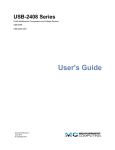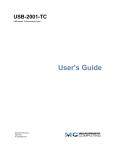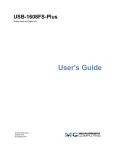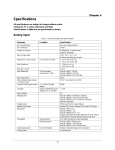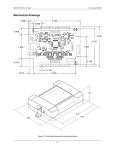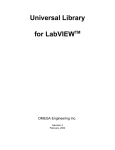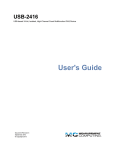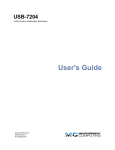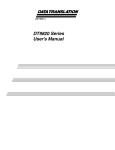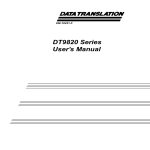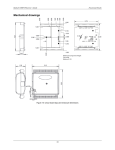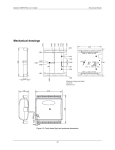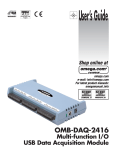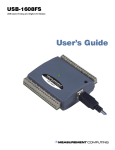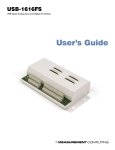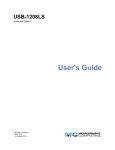Download USB-2408 Series User's Guide
Transcript
USB-2408 Series Multifunction DAQ Devices USB-2408 USB-2408-2AO User's Guide Document Revision 1 July 2011 © Copyright 2011 Your new Measurement Computing product comes with a fantastic extra – Management committed to your satisfaction! Refer to www.mccdaq.com/execteam.html for the names, titles, and contact information of each key executive at Measurement Computing. Thank you for choosing a Measurement Computing product – and congratulations! You own the finest, and you can now enjoy the protection of the most comprehensive warranties and unmatched phone tech support. It’s the embodiment of our mission: To provide data acquisition hardware and software that will save time and save money. Simple installations minimize the time between setting up your system and actually making measurements. We offer quick and simple access to outstanding live FREE technical support to help integrate MCC products into a DAQ system. Limited Lifetime Warranty: Most MCC products are covered by a limited lifetime warranty against defects in materials or workmanship for the life of the product, to the original purchaser, unless otherwise noted. Any products found to be defective in material or workmanship will be repaired, replaced with same or similar device, or refunded at MCC’s discretion. For specific information, please refer to the terms and conditions of sale. Harsh Environment Warranty® Program: Any Measurement Computing product that is damaged due to misuse, or any reason, may be eligible for replacement with the same or similar device for 50% of the current list price. I/O boards face some harsh environments, some harsher than the boards are designed to withstand. Contact MCC to determine your product’s eligibility for this program 30 Day Money-Back Guarantee: Any Measurement Computing Corporation product may be returned within 30 days of purchase for a full refund of the price paid for the product being returned. If you are not satisfied, or chose the wrong product by mistake, you do not have to keep it. These warranties are in lieu of all other warranties, expressed or implied, including any implied warranty of merchantability or fitness for a particular application. The remedies provided herein are the buyer’s sole and exclusive remedies. Neither Measurement Computing Corporation, nor its employees shall be liable for any direct or indirect, special, incidental or consequential damage arising from the use of its products, even if Measurement Computing Corporation has been notified in advance of the possibility of such damages. Trademark and Copyright Information Measurement Computing Corporation, InstaCal, Universal Library, and the Measurement Computing logo are either trademarks or registered trademarks of Measurement Computing Corporation. Refer to the Copyrights & Trademarks section on mccdaq.com/legal for more information about Measurement Computing trademarks. Other product and company names mentioned herein are trademarks or trade names of their respective companies. © 2011 Measurement Computing Corporation. All rights reserved. No part of this publication may be reproduced, stored in a retrieval system, or transmitted, in any form by any means, electronic, mechanical, by photocopying, recording, or otherwise without the prior written permission of Measurement Computing Corporation. Notice Measurement Computing Corporation does not authorize any Measurement Computing Corporation product for use in life support systems and/or devices without prior written consent from Measurement Computing Corporation. Life support devices/systems are devices or systems that, a) are intended for surgical implantation into the body, or b) support or sustain life and whose failure to perform can be reasonably expected to result in injury. Measurement Computing Corporation products are not designed with the components required, and are not subject to the testing required to ensure a level of reliability suitable for the treatment and diagnosis of people. HM USB-2408-Series.doc 2 Table of Contents About this User's Guide ....................................................................................................................... 5 What you will learn from this user's guide ......................................................................................................... 5 Conventions in this user's guide ......................................................................................................................... 5 Where to find more information ......................................................................................................................... 5 Chapter 1 Introducing the USB-2408 Series ........................................................................................................ 6 Overview: USB-2408 Series features ................................................................................................................. 6 USB-2408 Series block diagram ........................................................................................................................ 7 Chapter 2 Installing a USB-2408 Series Device ...................................................................................................8 What comes with your shipment? ....................................................................................................................... 8 Hardware .......................................................................................................................................................................... 8 Documentation .................................................................................................................................................................. 8 Unpacking........................................................................................................................................................... 8 Installing the software ........................................................................................................................................ 9 DAQFlex .......................................................................................................................................................................... 9 Universal Library and InstaCal ......................................................................................................................................... 9 Installing the hardware ....................................................................................................................................... 9 Calibrating ........................................................................................................................................................ 10 Self-calibration ................................................................................................................................................................10 Factory calibration ...........................................................................................................................................................10 Programming and developing applications....................................................................................................... 10 Chapter 3 Functional Details ............................................................................................................................... 11 External components ........................................................................................................................................ 11 USB connector .................................................................................................................................................................11 LEDs ................................................................................................................................................................................11 Screw terminals................................................................................................................................................................12 Signal connections ............................................................................................................................................ 13 Input isolation ..................................................................................................................................................................13 Analog/TC input ..............................................................................................................................................................14 Analog input mode...........................................................................................................................................................14 Gain queue .......................................................................................................................................................................15 TC input mode .................................................................................................................................................................15 Analog output (USB-2408-2AO only) .............................................................................................................................17 Digital I/O ........................................................................................................................................................................18 Internal pull-up/pull-down capability ..............................................................................................................................18 External pull-up/pull-down capability .............................................................................................................................19 Counter input ...................................................................................................................................................................20 Ground .............................................................................................................................................................................20 Mechanical drawings ........................................................................................................................................ 21 Chapter 4 Specifications ...................................................................................................................................... 22 Analog input ..................................................................................................................................................... 22 Channel configurations ..................................................................................................................................... 23 Compatible sensors ..........................................................................................................................................................23 3 USB-2408 Series User's Guide Accuracy ........................................................................................................................................................... 23 Thermocouple measurement accuracy .............................................................................................................................23 Analog input DC voltage measurement accuracy ............................................................................................................24 Input bandwidth ...............................................................................................................................................................25 Noise performance ...........................................................................................................................................................25 Channel switching error ...................................................................................................................................................26 Throughput rate ................................................................................................................................................ 26 Analog voltage output (USB-2408-2AO only) ................................................................................................. 27 Analog input/output calibration ........................................................................................................................ 28 Digital input/output........................................................................................................................................... 29 Counter ............................................................................................................................................................. 30 Memory ............................................................................................................................................................ 30 Microcontroller ................................................................................................................................................. 30 Power ................................................................................................................................................................ 31 USB specifications ........................................................................................................................................... 31 Environmental .................................................................................................................................................. 31 Mechanical ....................................................................................................................................................... 31 Screw terminal connector type and pinout........................................................................................................ 31 Screw terminal pinout ......................................................................................................................................................32 Declaration of Conformity .................................................................................................................. 34 4 Preface About this User's Guide What you will learn from this user's guide This user's guide describes the Measurement Computing USB-2408 Series data acquisition devices and lists device specifications. Conventions in this user's guide For more information about … Text presented in a box signifies additional information and helpful hints related to the subject matter you are reading. Caution! Shaded caution statements present information to help you avoid injuring yourself and others, damaging your hardware, or losing your data. bold text Bold text is used for the names of objects on a screen, such as buttons, text boxes, and check boxes. italic text Italic text is used for the names of manuals and help topic titles, and to emphasize a word or phrase. Where to find more information Additional information about USB-2408 Series hardware is available on our website at www.mccdaq.com. You can also contact Measurement Computing Corporation by phone, fax, or email with specific questions. Phone: 508-946-5100 and follow the instructions for reaching Tech Support. Fax: 508-946-9500 to the attention of Tech Support Email: [email protected] 5 Chapter 1 Introducing the USB-2408 Series Overview: USB-2408 Series features The USB-2408 Series includes the following devices: USB-2408 USB-2408-2AO These devices are USB 2.0 full-speed devices that are supported under the following operating systems: Microsoft Windows 7/Vista/XP (32-bit or 64-bit) Microsoft Windows CE Macintosh (32-bit or 64-bit) Linux (32-bit or 64-bit) Each USB-2408 Series device provides the following features: 16 single-ended (SE) or eight differential (DIFF) 24-bit analog inputs with sampling rates up to 1 kS/s. Each channel is software-configurable as SE or DIFF. For each DIFF channel pair, you lose one SE channel. Analog input ranges of ±10 V, ±5 V, ±2.5 V, ±1.25 V, ±0.625 V, ±0.312 V, ±0.156 V, and ±0.078 V. Up to eight analog inputs can be configured as DIFF thermocouple (TC) inputs, which include built-in cold-junction compensation and open TC detection. Computer protection provided through a minimum of 500 VDC input isolation between field wiring and the USB interface. Eight lines of digital I/O and two 32-bit counters. Screw terminals for field wiring connections The USB-2408-2AO also provides two 16-bit analog output channels. You can pace a single channel at rates of up to 1 kS/s. You can pace both channels simultaneously at rates of up to 500 S/s. 6 USB-2408 Series User's Guide Introducing the USB-2408 Series USB-2408 Series block diagram USB-2408 Series functions are illustrated in the block diagram shown here. Figure 1. USB-2408 Series functional block diagram 7 Chapter 2 Installing a USB-2408 Series Device What comes with your shipment? As you unpack your USB-2408 Series device, verify that the following components are included. Hardware USB-2408 Series device (USB-2408 or USB-2408-2AO) USB cable (2-meter length) Documentation In addition to this hardware user's guide, a Quick Start Guide booklet is included with the USB-2408 Series shipment. This booklet provides an overview of the MCC DAQ software you received with the device, and includes information about installing the software. Please read this booklet completely before installing any software or hardware. Unpacking As with any electronic device, take care while handling to avoid damage from static electricity. Before removing the USB-2408 Series device from its packaging, ground yourself using a wrist strap or by simply touching the computer chassis or other grounded object to eliminate any stored static charge. If the device is damaged, notify Measurement Computing Corporation immediately by phone, fax, or e-mail. Phone: 508-946-5100 and follow the instructions for reaching Tech Support. Fax: 508-946-9500 to the attention of Tech Support Email: [email protected] For international customers, contact your local distributor. Refer to the "International Distributors" section on our web site at www.mccdaq.com/contact2.aspx. 8 USB-2408 Series User's Guide Installing a USB-2408 Series Device Installing the software Note: Before installing a USB-2408 Series device, you must install the software you plan to use with the device. The USB-2408 Series is supported by DAQFlex software and Universal Library and InstaCal software. You can install both software packages on your computer. However, you cannot run both software packages simultaneously with one USB-2408 Series device. DAQFlex Install DAQFlex software when you want to develop data acquisition applications that can be deployed across multiple operating systems and custom embedded systems. DAQFlex software for each supported operating system is available from the DAQFlex download page at www.mccdaq.com/DAQFlexDL. Refer to the DAQFlex Software User's Guide at www.mccdaq.com/pdfs/manuals/DAQFlex%20Software.pdf for instructions about installing DAQFlex software. Universal Library and InstaCal Install Universal Library and InstaCal when you want to develop data acquisition applications using Windows programming languages. Universal Library and InstaCal software are included on the CD that ships with the device. Refer to the Quick Start Guide booklet for instructions about installing Universal Library and InstaCal software. Installing the hardware Install the software before you install your device A driver needed to run the USB-2408 Series device is installed when you install the software. Therefore, you need to install the software package you plan to use before you install the hardware. For operation on a Windows operating system, we recommend that you run Windows Update to update your operating system with the latest USB drivers. To connect a USB-2408 Series device to your system, turn on your computer and connect the USB cable to an available USB port on the computer or to an external USB hub connected to the computer. Connect the other end of the USB cable to the USB connector on the device. No external power is required. When you connect the device for the first time to a computer running Windows, a Found New Hardware dialog opens when the operating system detects the device. The dialog closes after the device is installed. A green Status LED indicates the device status. When the LED is on, the device is powered and ready for operation. If the LED is not on, the device is not powered or did not initialize. Figure 2 on page 11 shows the location of the STATUS LED. Mac OS X When connecting the device to a computer running the Mac OS X operating system, the Status LED does not turn on until the device is configured by application software. Caution! Do not disconnect any device from the USB bus while the computer is communicating with the USB-2408 Series device, or you may lose data and/or your ability to communicate with the device. If the Status LED turns off If the Status LED turns on but then turns off, the computer has lost communication with the USB-2408 Series device. To restore communication, disconnect the USB cable from the computer and then reconnect it. This should restore communication, and the Status LED should turn on. 9 USB-2408 Series User's Guide Installing a USB-2408 Series Device Calibrating Self-calibration USB-2408 Series hardware supports self-calibration. You should calibrate the device whenever the ambient temperature changes by more than ±10 °C from the last self-calibration. Use either InstaCal or the DAQFlex FlexTest utility to calibrate the device. Factory calibration The Measurement Computing Manufacturing Test department performs the initial factory calibration. Contact Measurement Computing for details about how to return your device and have it calibrated to the factory specifications. Programming and developing applications You can program and develop applications for the USB-2408 Series device using MCC DAQ software and DAQFlex software. OEM users can create a custom driver for use with the message-based firmware to interface with the device. Refer to the Quick Start Guide for information about the Universal Library and InstaCal. Refer to the DAQFlex Software User's Guide for information about DAQFlex software. Refer to the Message-based Firmware Specification for information about the message-based firmware. 10 Chapter 3 Functional Details External components USB-2408 Series devices have the following external components: USB connector LEDs Screw terminals Figure 2 shows the location of each component. Figure 2. USB-2408 Series components USB connector The USB connector provides +5 V power and communication. No external power supply is required. LEDs USB-2408 Series devices have two LEDs – STATUS and ACTIVITY. The Status LED is lit when the device is detected and installed on the computer. The Activity LED indicates the communication status of a device. This LED blinks when data is transferred, and is off when the device is not communicating. Figure 3 shows the location of each LED. Figure 3. USB-2408 Series LEDs 11 USB-2408 Series User's Guide Functional Details Screw terminals USB-2408 Series devices have two banks of screw terminals. Screw terminal functions for DIFF and SE modes are identified in Figure 5 and Figure 4. The USB-2408 Series device screw terminals provide the following connections: 16 SE (CH0 to CH15 – see Figure 4) or eight DIFF (CH0H/CH0L to CH7H/CH7L) analog input connections Eight digital I/O connections (DI00 to DI07) Two analog output connections (AOUT0, AOUT1) – USB-2408-2AO only Two counter inputs (CTR0, CTR1) One power output (+5V) 10 analog grounds (AGND), four digital grounds (DGND), and one chassis ground (CHAS) Figure 4. SE mode pin out * These pins are labeled "NC" (no connection) on the USB-2408. 12 USB-2408 Series User's Guide Functional Details Figure 5. DIFF mode pin out * These pins are labeled "NC" (no connection) on the USB-2408. Signal connections Input isolation USB-2408 Series devices are isolated data acquisition devices. The analog I/O, digital I/O, counters, and all the digital control/timing are referenced to an isolated ground as shown in the figure below. This ground is physically and electrically separate from the ground used by the circuit connected to the system bus interface. Isolation provides a barrier between the host computer and potentially hazardous voltages by physically and electrically separating two parts of the measurement device. The "non-isolated" ground is common to the chassis ground of the computer, while the "isolated" ground is not. All analog measurements are made relative to the isolated ground. See Figure 6 for details. Figure 6. USB-2408 Series input isolation diagram 13 USB-2408 Series User's Guide Functional Details When making measurements in industrial environments, DAQ devices can encounter hazardous voltages, transients, large common mode voltages and fluctuating ground potentials. Any one of these issues can seriously degrade the measurement accuracy of the device and possibly damage the measurement instrument. To overcome these issues, some DAQ devices provide physical and electrical isolation. Some of the benefits of isolation include: Safety: A DAQ device employing physical and electrical isolation helps to keep high voltages and transients from damaging the system-side host computer. Ground loops: Improper grounding of the signal source that the DAQ device is measuring is one of the most common sources of noise and measurement inaccuracies. Isolation improves the measurement accuracy by physically preventing ground loops. Ground loops – a common source of noise and error – are the results of a measurement system having multiple grounds at different potentials. Common mode rejection: With isolation, a DAQ device can measure small signals in the presence of large common mode voltages. Isolation increases the ability of the measurement system to reject common mode voltages. The common mode voltage is the signal that is common to both the positive and negative inputs of the measurement device, but is not part of the signal to measure. Analog/TC input Each analog input channel has the following measurement parameters: Voltage input range TC type J, K, T, E, R, S, B, or N You can select a unique input range or signal type for each channel. For example, one channel could be used for volts and another for temperature. Analog input mode You can configure the analog inputs for SE or DIFF mode. The input voltage range is software selectable for ±10 V, ±5 V, ±2.5 V, ±1.25 V, ±0.625 V, ±0.312 V, ±0.156 V, or ±0.078 V. With SE mode, connect up to 16 inputs to screw terminals CH0 to CH15. SE mode requires two wires: Connect one wire to the signal you want to measure (CHx). Connect one wire to the analog ground reference (AGND). Refer to Figure 4 on page 12 for the location of the SE inputs. With DIFF mode, connect up to eight differential inputs to screw terminals CH0H/CH0L to CH7H/CH7L. DIFF mode requires two wires plus a ground reference: Connect one wire to the high/positive signal (CHxH). Connect one wire to the low/negative signal (CHxL). Connect one wire to the analog ground reference (AGND). Refer to Figure 5 on page 13 for the location of the DIFF inputs. When connecting DIFF voltage inputs to a "floating" voltage source, make sure there is a DC return path from each voltage input to ground. You make this path by connecting a resistor from each low channel input to an AGND pin. A value of approximately 100 kΩ can be used for most applications. This does not apply to channels configured for TC input, as they have their own internal reference. Leave unused input channels either floating or tied to an AGND terminal. Source impedances should be kept as small as possible to avoid settling time and accuracy errors. 14 USB-2408 Series User's Guide Functional Details Figure 7 shows a DIFF voltage connection using a ground path resistor. Figure 7. DIFF voltage connection with ground path resistor example Gain queue Use the USB-2408 Series channel - gain queue feature to configure a list of channels, modes, and gains for each scan. The settings are stored in a channel – gain queue list that is written to local memory on the device. The channel - gain queue list contains one or more channel numbers and range settings. You can configure up to 64 elements. The channels can be listed in any order, and can include duplicate channels for sampling at different ranges. An example of a 12-element list is shown in the table below. Sample channel gain queue list Element Channel Range 0 1 2 3 4 5 6 7 8 9 10 11 CH0 CH1 CH0 CH4 CH8 CH0 CH1 CH7 CH0 CH15 CH9 CH10 BIP10V BIP5V BIP2Pt5VOLTS BIP2Pt5VOLTS BIP2Pt5VOLTS BIP5V BIP1Pt25VOLTS BIP5V BIP1Pt25VOLTS BIP10V BIP1Pt25VOLTS BIP2Pt5VOLTS Carefully match the gain to the expected voltage range on the associated channel or an over range condition may occur. Although this condition does not damage the device, it does produce a useless full-scale reading, and can introduce a long recovery time due to saturation of the input channel. For more information about analog signal connections For more information about analog input connections, refer to the Guide to Signal Connections (this document is available on our web site at www.mccdaq.com/signals/signals.pdf). TC input mode You can make up to eight high-resolution DIFF TC measurements with a USB-2408 Series device. Built-in cold-junction compensation sensors are provided for each of the screw-terminal blocks and any supported TC type can be attached to any of the 8 TC channels. Do not connect TCs as SE – doing so can cause false readings. 15 USB-2408 Series User's Guide Functional Details You do not need to use ground-referencing resistors for TC inputs because the analog front-end circuit levelshifts the TC output into the common-mode input range of the A/D. USB-2408 Series devices also provide an open TC detection feature for each of the analog input channels configured for TC measurement. This feature is enabled or disabled by software, and when enabled, it detects if an open-circuit condition exists at the TC sensor. USB-2408 Series devices provide electrostatic discharge (ESD) protection for each of the TC inputs. However, before handling TC sensors, follow standard ESD practices and discharge any accumulated ESD charge. Once the TC sensor is connected to the device, the configuration options have been selected, and the recommended 45 minute warm up has elapsed, the device is ready to make high-resolution DIFF temperature measurements. Built-in cold junction compensation (CJC) automatically compensates for the additional thermal EMFs generated by connecting the TC leads to the USB-2408 Series device terminal blocks. CJC is performed using a high-resolution temperature sensor connected close to the device terminal blocks. The device includes two separate CJC sensors – one on each side of the PCB. Software corrects for the additional TCs created at the terminals. Once the A/D and CJC data is collected, the application software uses this data to linearize to an accurate temperature reading. The TC linearization uses the latest NIST linearization coefficients for each of the eight TC types supported by USB-2408 Series devices. When configuring TC sensors, keep any stray capacitance as small as possible relative to AGND to avoid settling time and accuracy errors. For TC channels, do not provide a return path to ground. This is done internally. Figure 8 shows a typical TC connection. Figure 8. DIFF TC connection example Noise filtering, data rate and throughput rate Although the USB-2408 Series A/D converter has a maximum data rate of 3,750 samples per second, the actual throughput rate you observe for voltage and temperature data is determined by these formulas. Maximum single-channel throughput: Maximum multiple-channel throughput: where n is the number of channels See Table 18 and Table 19 in the "Specifications" chapter for details. 16 USB-2408 Series User's Guide Functional Details This drop-off in throughput rate is due to the noise filtering feature in the device. You can control the amount of the noise filtering by adjusting the data rate setting. By reducing the data rate, the averaging of samples increases, and noise drops correspondingly. Figure 9 illustrates this inverse relationship. This graph applies to the A/D converter only – do not expect this level of performance from a USB-2408 Series device itself. Figure 9. USB-2408 Series A/D converter data rate vs. noise graph If low noise is your main concern, you can operate the USB-2408 Series device at very low data rates starting from 2.5 samples per second (S/s). At low rates, much of the noise is averaged out of the data, and issues such as reference noise become less important. At higher data rates, higher-frequency noise sources are not averaged out and begin to be troublesome. These noise sources include the noise inherent in the A/D converter itself, which is not reducible. Since TCs can pick up noise in your environment, select a data rate based on the primary noise frequency. For example, to reduce the effect of 60 Hz noise, select a data rate of 60 (or a supported submultiple of 60, such as 10 or 5). Multiple-channel throughput rates When setting different sample rates for channels, be aware that all the channels will be sampled within the same sample window based on the channel with the lowest sample rate. For example, if you set a 10 Hz data rate for channel 0, and a 50 Hz data rate for channel 1, basically, both channels pass the same number of samples per second to the host computer. However, more averaging is performed on channel 0 samples; therefore, channel 0 is sampled at a higher resolution. The USB-2408 Series A/D converter performs averaging, and the number of averages equals 30,000/data rate. In this example, channel 0 is sampled 3000 times over 100 ms, and all samples are averaged into one sample. Then, channel 1 is sampled 600 times over 20 ms, and samples are likewise averaged into one sample. The final samples are available to you at a maximum rate of about 8 Hz (8.245 Hz). Figure 10. USB-2408 Series data rate vs. resolution example Analog output (USB-2408-2AO only) The USB-2408-2AO has two 16-bit analog outputs (AOUT0 and AOUT1). Both outputs can be updated simultaneously at a rate of 500 S/s per channel. One output can be updated at a rate of 1000 S/s. The output range is fixed at ±10 V. The outputs default to 0 V when the host computer is shut down or suspended, or when a reset command is issued to the device. 17 USB-2408 Series User's Guide Functional Details Digital I/O You can connect up to eight digital I/O lines to DIO0 through DIO7. The digital I/O terminals can detect the state of any TTL-level input. Digital input voltage ranges of up to 0 to +15 V are permitted, with thresholds of 0.6 V (low) and 2.2 V (high). Each DIO channel is an open-drain, which, when used as an output, is capable of sinking up to 150 mA for direct drive applications. Figure 11 shows an example of a typical DIO connection. Figure 11. Digital output connection example The figure represents connections for one channel. The other seven channels are connected in the same manner. The maximum sink current is 150 mA per 8-channel bank, or if all eight channels are used, 18 mA (maximum) per channel. Internal pull-up/pull-down capability Unconnected inputs are pulled low by default to 0 V through 47 kΩ resistors via jumper J6 on the circuit board. The pull-up/pull-down voltage is common to all 47 kΩ resistors. Complete the following steps to configure these inputs to pull high (+5V). Caution! The discharge of static electricity can damage some electronic components. Before removing the USB-2408 Series device from its housing, ground yourself using a wrist strap or touch the computer chassis or other grounded object to eliminate any stored static charge. To open the case and set the J6 jumper, do the following. 1. Turn the device over and rest the top of the housing on a flat, stable surface. 2. Peel off the four rubber feet on the bottom of the device to access the screws. 3. Remove the four screws from the bottom of the device. 4. Hold both the top and bottom sections together, turn the device over and rest it on the surface, then carefully remove the top section of the case to expose the circuit board. 18 USB-2408 Series User's Guide 5. Functional Details Configure jumper J6 for either pull-up, pins 1-2, or pull-down, pins 2-3. The jumper is configured by default for pull-up. Figure 12 shows the location of the jumper on the board. Figure 12. Location of J6 jumper Figure 13 shows the jumper configured for pull-up and pull-down. Figure 13. J6 jumper configurations 6. Replace the top section of the case, and fasten it to the bottom section with the four screws. Replace the rubber feet. For more information about digital signal connections For general information about digital signal connections and digital I/O techniques, refer to the Guide to Signal Connections (available on our web site at www.mccdaq.com/signals/signals.pdf). The pull-up/pull-down voltage is common to all of the internal 47 kΩ resistors. External pull-up/pull-down capability You can also place an external pull-up resistor on any of the DIO bits, which enables you to pull the DIO bit up to a voltage that exceeds the internal +5 V pull-up voltage. When using external pull-up resistors, be aware of the following: You should either remove the J6 jumper, or store it by attaching it to one of the three pins. When using external pull-up resistors, be aware that the internal resistors cause a slight voltage impedance shift to digital lines in the "on" state as various lines change between the on/off states. 19 USB-2408 Series User's Guide J6 +5 V Functional Details +V 47 kΩ Internal jumper disabled (placed on center pin only) External pull-up resistor DIO0 DIO1 DIO2 DIO3 DIO4 DIO5 DIO6 DIO7 Figure 14. Digital I/O external resistor configuration Counter input The CTR0 and CTR1 terminals are 32-bit event counters that can accept frequency inputs up to 1 MHz. The internal counter increments when the TTL levels transition from low to high. Ground The analog ground (AGND) terminals provide a common ground for all analog channels. The digital ground (GND) terminals provide a common ground for the digital and counter channels and the power terminal. 20 USB-2408 Series User's Guide Functional Details Mechanical drawings Figure 15. USB-2408 Series device circuit board (top) and enclosure dimensions 21 Chapter 4 Specifications All specifications are subject to change without notice. Typical for 25 °C unless otherwise specified. All specifications apply to all temperature and voltage input channels unless otherwise specified. Specifications in italic text are guaranteed by design. Analog input Table 1. General analog input specifications Parameter Conditions A/D converter type A/D data rates ADS1256, 24-bit Sigma Delta 3750 S/s, 2000 S/s, 1000 S/s, 500 S/s, 100 S/s, 60 S/s, 50 S/s, 25 S/s, 10 S/s, 5 S/s, 2.5 S/s Single channel: 2.5 S/s to 1102.94 S/s (software-selectable) Multiple channels: 0.16 S/s to 551.47 S/s (software-selectable) See Table 11 and Table 12 for details. 16 single-ended or 8 differential (software-selectable). Thermocouples require differential mode. For each channel configured as differential, you essentially lose two single-ended channels. 500 VDC min between field wiring and USB interface Temperature sensor input, software-selectable to match sensor type Voltage input Throughput Number of channels Input isolation Channel configurations Input voltage range Absolute maximum input voltage Thermocouple mode ±0.078125 V Voltage mode (Note 1) ±10 V, ±5 V, ±2.5 V, ±1.25 V, ±0.625 V, ±0.3125 V, ±0.15625 V, ±0.078125 V (software-selectable) ±22 V max (power on) ±10 V max (power off) 10 MΩ (power on) 390 Ω (power off) ±20 nA CxH-CxL relative to GND Input impedance Input leakage current Input voltage >±30 V (power on/off) Input capacitance Maximum working voltage (signal + common mode) Common mode rejection ratio (Note 1) ADC resolution Crosstalk Input coupling Channel gain queue Warm-up time Open thermocouple detect CJC sensor accuracy Specification Voltage mode Thermocouple mode, (fIN = 60 Hz) Voltage mode, (fIN = 60 Hz, all input ranges) Adj chan, DIFF mode Up to 64 elements 15 °C to 35 °C ±1 µA max 590 pf ±10.25 V max 110 dB 90 dB 24 bits 100 dB DC Software-selectable channel and range 45 minutes min Software-selectable for each channel. ±0.5 °C typ 22 USB-2408 Series User's Guide Specifications 0 °C to 55 °C Note 1: ±1.0 °C max Placing a notch of the A/D digital filter at 60 Hz (setting A/D data rate = 60 S/s, 10 S/s, 5 S/s or 2.5 S/s) further improves the common mode rejection of this frequency. Channel configurations When any item is changed, the firmware stores channel configurations in the EEPROM of the isolated microcontroller. An external application issues commands over the USB to make changes, and the configuration is made non-volatile through the use of the EEPROM. When connecting differential voltage inputs to a floating voltage source, provide a DC return path from each voltage input to ground. To do this, connect a resistor from each input to an AGND pin. A value of approximately 100 kΩ can be used for most applications. Leave unused input channels either floating or tied to AGND. For each voltage/thermocouple channel configured as differential, you essentially lose one single-ended channel. Keep source impedances as small as possible to avoid settling time and accuracy errors. Table 2. Channel configurations Channel Category Specification CxH/CxL CxH/CxL CxH/CxL Thermocouple Voltage Voltage 8 differential channels 16 individually-configurable channels that can be configured as either single-ended or 8 differential. Compatible sensors Table 3. Compatible sensor type specifications Parameter Conditions Thermocouple J: –210 °C to 1200 °C K: –270 °C to 1372 °C R: –50 °C to 1768 °C S: –50 °C to 1768 °C T: –270 °C to 400 °C N: –270 °C to 1300 °C E: –270 °C to 1000 °C B: 0 °C to 1820 °C Accuracy Thermocouple measurement accuracy Thermocouple measurement accuracy specifications include polynomial linearization error, cold-junction compensation measurement error, and are for sample rates up to 60S/s. These specs are for one year, or 3000 operating hours, whichever comes first. There is a CJC sensor for each terminal block of the module. The accuracy listed below assumes the screw terminals are at the same temperature as the CJC sensor. The accuracy errors shown do not include the inherent accuracy error of the thermocouple sensor itself. Contact your thermocouple supplier for details on the actual thermocouple sensor accuracy limitations. Connect thermocouples to the USB-2408 Series device such that they are floating with respect to AGND . When configuring thermocouple sensors, keep any stray capacitance relative to AGND as small as possible to avoid settling time and accuracy errors. The AGND and DGND pins are isolated from earth ground. You can connect thermocouple sensors to voltages referenced to earth ground as long as isolation between the AGND/DGND pins and earth ground is maintained. 23 USB-2408 Series User's Guide Specifications Table 4. Thermocouple accuracy specifications, including CJC measurement error. All specifications are (±). Thermocouple J K N R S B E T Sensor temperature range –210 °C 0 °C 1200 °C –210 °C 0 °C 1372 °C –200 °C 0 °C 1300 °C –50 °C 250 °C 1768 °C –50 °C 250 °C 1768 °C 250 °C 700 °C 1820 °C –200 °C 0 °C 1000 °C –200 °C 0 °C 400 °C Accuracy error, maximum 2.572 °C 0.935 °C 1.869 °C 2.917 °C 1.017 °C 2.478 °C 3.480°C 1.201 °C 1.991 °C 4.826 °C 2.117 °C 2.842 °C 4.510 °C 2.165 °C 3.187 °C 5.489 °C 2.283 °C 2.202 °C 2.413 °C 1.069 °C 1.575 °C 2.821 °C 1.050 °C 0.957 °C Accuracy error, typical 1.416 °C 0.469 °C 1.456 °C 1.699 °C 0.526 °C 2.022 °C 2.030 °C 0.659 °C 1.600 °C 3.133 °C 1.424 °C 2.347 °C 2.930 °Co 1.468 °C 2.597 °C 3.956 °C 1.743 °C 1.842 °C 1.352 °C 0.551 °C 1.211 °C 1.676 °C 0.558 °C 0.595 °C Tempco (°C/°C) 0.022 0.029 0.029 0.082 .089 0.14 0.017 0.027 To achieve the thermocouple accuracies listed above, warm up the USB-2408 Series device for 45 minutes after the initial power on. The accuracies listed above are only guaranteed if the device is housed in the plastic enclosure. Analog input DC voltage measurement accuracy Table 5. DC Accuracy components and specifications. All values are (±) Range Gain error (% of reading) Offset error INL error (% of range) Absolute accuracy Gain temperature coefficient (% reading/°C) ±10 V ±5 V ±2.5 V ±1.25 V ±0.625 V ±0.3125 V ±0.15625 V ±0.078125 V 0.0037 0.0047 0.0059 0.0056 0.0068 0.0104 0.0184 0.0384 50 µV 25 µV 20 µV 20 µV 15 µV 15 µV 10 µV 10 µV 0.0008 0.0008 0.0008 0.0008 0.0005 0.0006 0.0005 0.0009 500 µV 300 µV 200 µV 100 µV 60 µV 50 µV 40 µV 40 µV 0.0006 0.0006 0.0006 0.0006 0.0006 0.0006 0.0006 0.0006 24 Offset temperature coefficient (µV/°C) 3 2 1 1 1 1 1 1 USB-2408 Series User's Guide Specifications Input bandwidth Table 6. input bandwidth A/D data rate –3 db Bandwidth (Hz) 3750 S/s 2000 S/s 1000 S/s 500 S/s 100 S/s 60 S/s 50 S/s 25 S/s 10 S/s 5 S/s 2.5 S/s 1615 878 441 221 44.2 26.5 22.1 11.1 4.42 2.21 1.1 Noise performance For the peak-to-peak noise distribution test, a differential input channel is connected to AGND at the input terminal block, and 50,000 samples are acquired at the maximum rate available at each setting. Table 7. Peak-to-peak noise performance specifications (µV) A/D data rate Range 3750 S/s 2000 S/s 1000 S/s 500 S/s 100 S/s 60 S/s 50 S/s 25 S/s 10 S/s 5 S/s 2.5 S/s ±10 V ±5 V ±2.5 V ±1.25 V ±0.625 V ±0.3125 V ±0.15625 V 126.84 56.74 32.96 18.57 18.88 15.33 13.28 100.14 47.56 28.79 17.52 16.58 14.76 16.84 71.76 34.21 17.94 13.83 8.45 8.19 7.47 45.06 25.87 14.19 9.30 7.41 6.94 6.61 30.52 16.21 7.51 5.48 5.32 4.75 5.70 30.52 14.31 7.09 5.48 4.80 4.69 4.48 26.70 14.31 7.09 5.01 4.38 4.49 4.48 19.07 14.30 5.72 3.81 3.86 3.70 4.24 11.92 5.96 3.81 3.34 2.50 3.34 2.66 9.54 4.77 4.00 3.34 2.61 2.56 3.07 9.54 4.77 4.00 2.86 1.98 2.45 2.29 ±0.078125 V 13.47 15.02 9.17 6.88 4.28 4.16 4.00 3.57 2.28 2.13 2.40 Table 8. RMS noise performance specifications (µVRMS) A/D data rate Range 3750 S/s 2000 S/s 1000 S/s 500 S/s 100 S/s 60 S/s 50 S/s 25 S/s 10 S/s 5 S/s 2.5 S/s ±10 V ±5 V ±2.5 V ±1.25 V ±0.625 V ±0.3125 V ±0.15625 V ±0.078125 V 19.22 8.60 4.99 2.81 2.86 2.32 2.01 2.04 15.17 7.21 4.36 2.66 2.51 2.24 2.55 2.28 10.87 5.18 2.72 2.10 1.28 1.24 1.13 1.39 6.83 3.92 2.15 1.41 1.12 1.05 1.00 1.04 4.62 2.46 1.14 0.83 0.81 0.72 0.86 0.65 4.62 2.17 1.07 0.83 0.73 0.71 0.68 0.63 4.05 2.17 1.07 0.76 0.66 0.68 0.68 0.60 2.89 2.16 0.87 0.58 0.58 0.56 0.64 0.54 1.81 0.90 0.58 0.51 0.38 0.51 0.40 0.35 1.44 0.72 0.60 0.51 0.40 0.39 0.47 0.32 1.44 0.72 0.60 0.43 0.30 0.37 0.35 0.36 25 USB-2408 Series User's Guide Specifications Table 9. Noise-free resolution specifications (bits) A/D data rate Range 3750 S/s 2000 S/s 1000 S/s 500 S/s 100 S/s 60 S/s 50 S/s 25 S/s 10 S/s 5 S/s 2.5 S/s ±10 V ±5 V ±2.5 V ±1.25 V ±0.625 V ±0.3125 V ±0.15625 V ±0.078125 V 17.2 17.4 17.2 17.0 16.0 15.3 14.5 14.5 17.6 17.6 17.4 17.1 16.2 15.3 14.1 14.3 18.1 18.1 18.1 17.4 17.1 16.2 15.3 15.0 18.7 18.5 18.4 18.0 17.3 16.4 15.5 15.4 19.3 19.2 19.3 18.8 17.8 17.0 15.7 16.1 19.3 19.4 19.4 18.8 18.0 17.0 16.1 16.2 19.5 19.4 19.4 18.9 18.1 17.0 16.1 16.2 20.0 19.4 19.7 19.3 18.3 17.3 16.1 16.4 20.6 20.6 20.3 19.5 18.9 17.5 16.8 17.0 21.0 21.0 20.7 19.5 18.8 17.9 16.9 17.1 21.0 21.0 21.0 19.7 19.2 17.9 17.1 16.9 Channel switching error Table 10. Step response accuracy specifications Accuracy Range 3750 S/s 2000 S/s 1000 S/s 500 S/s 100 S/s 60 S/s 50 S/s 25 S/s 10 S/s 5 S/s 2.5 S/s ±10 V ±5 V ±2.5 V ±1.25 V ±0.625 V ±0.3125 V ±0.15625 V ±0.078125 V 0.0010% 0.0009% 0.0010% 0.0013% 0.0022% 0.0031% 0.0056% 0.0114% 0.0008% 0.0008% 0.0007% 0.0009% 0.0016% 0.0031% 0.0062% 0.0123% 0.0005% 0.0004% 0.0008% 0.0008% 0.0011% 0.0020% 0.0048% 0.0076% 0.0004% 0.0004% 0.0004% 0.0007% 0.0011% 0.0017% 0.0037% 0.0070% 0.0002% 0.0003% 0.0003% 0.0004% 0.0007% 0.0015% 0.0032% 0.0041% 0.0002% 0.0002% 0.0002% 0.0004% 0.0007% 0.0012% 0.0025% 0.0051% 0.0003% 0.0002% 0.0002% 0.0003% 0.0005% 0.0010% 0.0024% 0.0046% 0.0002% 0.0002% 0.0002% 0.0003% 0.0005% 0.0010% 0.0021% 0.0036% 0.0001% 0.0001% 0.0002% 0.0003% 0.0004% 0.0012% 0.0019% 0.0032% 0.0001% 0.0001% 0.0001% 0.0003% 0.0005% 0.0009% 0.0022% 0.0030% 0.0001% 0.0001% 0.0001% 0.0003% 0.0003% 0.0009% 0.0016% 0.0034% Channel switching error is defined as the accuracy that can be expected after one conversion when switching from a channel with a DC input at one extreme of full scale to another channel with a DC input at the other extreme of full scale, expressed in terms of percentage of full scale value. Throughput rate The single channel throughput rate is calculated using this formula: 1 1 + 640 µs data rate Maximum throughput = Table 11. Single channel throughput rate specifications A/D data rate Maximum throughput (Hz) 3750 S/s 2000 S/s 1000 S/s 500 S/s 100 S/s 60 S/s 50 S/s 25 S/s 10 S/s 5 S/s 2.5 S/s 1102.94 877.19 609.76 378.79 93.98 57.78 48.45 24.61 9.94 4.98 2.50 26 USB-2408 Series User's Guide Specifications The multiple-channel throughput rate is calculated using this formula: Maximum throughput = 1 , where n is the number of channels 1 + 640 μs data rate n ∑ Table 12. Multiple-channel throughput rate specifications (Hz) Number of input channels 3750 S/s 2000 S/s 1000 S/s 500 S/s 100 S/s 60 S/s 50 S/s 25 S/s 10 S/s 5 S/s 2.5 S/s 1 2 3 4 5 6 7 8 9 10 11 12 13 14 15 16 1102.94 551.47 367.65 275.74 220.59 183.82 157.56 137.87 122.55 110.29 100.27 91.91 84.84 78.78 73.53 68.93 877.19 438.60 292.40 219.30 175.44 146.20 125.31 109.65 97.47 87.72 79.74 73.10 67.48 62.66 58.48 54.82 609.76 304.88 203.25 152.44 121.95 101.63 87.11 76.22 67.75 60.98 55.43 50.81 46.90 43.55 40.65 38.11 378.79 189.39 126.26 94.70 75.76 63.13 54.11 47.35 42.09 37.88 34.44 31.57 29.14 27.06 25.25 23.67 93.98 46.99 31.33 23.50 18.80 15.66 13.43 11.75 10.44 9.40 8.54 7.83 7.23 6.71 6.27 5.87 57.78 28.89 19.26 14.45 11.56 9.63 8.25 7.22 6.42 5.78 5.25 4.82 4.44 4.13 3.85 3.61 48.45 24.22 16.15 12.11 9.69 8.07 6.92 6.06 5.38 4.84 4.40 4.04 3.73 3.46 3.23 3.03 24.61 12.30 8.20 6.15 4.92 4.10 3.52 3.08 2.73 2.46 2.24 2.05 1.89 1.76 1.64 1.54 9.94 4.97 3.31 2.48 1.99 1.66 1.42 1.24 1.10 0.99 0.90 0.83 0.76 0.71 0.66 0.62 4.98 2.49 1.66 1.25 1.00 0.83 0.71 0.62 0.55 0.50 0.45 0.42 0.38 0.36 0.33 0.31 2.50 1.25 0.83 0.62 0.50 0.42 0.36 0.31 0.28 0.25 0.23 0.21 0.19 0.18 0.17 0.16 Analog voltage output (USB-2408-2AO only) Unused AOUTx output channels should be left disconnected. The USB-2408-2AO output voltage level defaults to 0 V whenever the host PC is reset, shut down or suspended, or if a reset command is issued to the device. The outputs may have a transient during startup. The duration of the output transient depends highly on the enumeration process of the host PC. Typically, the output of the USB-2408-2AO is stable after two seconds. Table 13. USB-2408-2AO analog voltage output specifications Parameter Digital-to-analog converter Number of channels Resolution Output ranges Output transient Conditions Specifications DAC8552 Calibrated Uncalibrated Host PC is reset, powered on, suspended or a reset command is issued to device Initial power on Differential non-linearity Output current Output short-circuit protection 2 16 bits ±10 V ±10.05 V (software-selectable) Duration: 2 s Amplitude: 2 V p-p Duration: 50 ms Amplitude: 5 V peak ±0.25 LSB typ ±1 LSB max ±5.0 mA max Unlimited duration AOUTx pins AOUTx connected to AGND 27 USB-2408 Series User's Guide Parameter Specifications Conditions Specifications To rated accuracy, 10 V step DC DACs cleared to zero-scale: 0 V, ±50 mV 60 µVrms (BW=1.5 KHz) 75 µS 1.0 V/µs 1000 S/s max, system-dependent 1000 S/s / #ch max, systemdependent Output coupling Power on and reset state Output noise Settling time Slew rate Throughput Single-channel Multi-channel Table 14. Calibrated absolute accuracy specifications Range Accuracy (±LSB) ±10 V 16.0 Table 15. Calibrated absolute accuracy components specifications Range % of reading Offset (±mV) Temp drift (%/°C) Absolute accuracy at FS (±mV) ±10 V ±0.0183 1.831 0.00055 3.661 Table 16. Relative accuracy specifications Range Relative accuracy (±LSB) ±10 V 4.0 typ Analog input/output calibration Table 17. Analog input/output calibration specifications Parameter Specifications Recommended warm-up time Calibration Calibration interval AI calibration reference 45 minutes min Firmware calibration 1 year +10.000 V, ±5 mV max. Actual measured values stored in EEPROM Tempco: 5 ppm/°C max Long term stability: 30 ppm/1000 hours The analog output pin is internally routed to the analog input pin. AO calibration procedure (USB-2408-2AO only) AOUTx readback (USB-2408-2AO only) Each AOUTx output can be independently measured by the onboard A/D converter. Software-selectable 28 USB-2408 Series User's Guide Specifications Digital input/output Table 18. Digital input specifications Parameter Specifications Number of I/O Configuration 8 channels Each DIO bit can be independently read from (DIN) or written to (DOUT). The DIN bits can be read at any time whether the DOUT is active or tri-stated. 0 to +15 V CMOS (Schmitt trigger) 47 kΩ pull-up/pull-down resistor, 28 kΩ series resistor 0 V to +20 V max (power on/off, relative to DGND) (Note 2) All pins pulled up to +5 V via individual 47 kΩ resistors (the J6 shorting block default position is pins 1 and 2). Pull down capability is available by placing the J6 shorting block across pins 2 and 3. 500 port reads or single bit reads per second typ. 1.3 V min, 2.2 V max 1.5 V max, 0.6 V min 0.4 V min, 1.2 V max Input voltage range Input type Input characteristics Maximum input voltage range Pull-up/pull-down configuration Transfer rate (software paced) Input high voltage Input low voltage Schmitt trigger hysteresis Note 2: DGND pins are recommended for use with digital input and digital output pins. The DGND and AGND pins are common and are isolated from earth ground. Table 19. Digital output specifications Parameter Specifications Number of I/O Configuration (Note3) 8 channels Each DIO bit can be independently read from (DIN) or written to (DOUT). The DIN bits may be read at any time whether the DOUT is active or tri-stated 47 kΩ pull-up, open drain (DMOS transistor) All pins pulled up to +5 V via individual 47 kΩ resistors (the J6 shorting block default position is pins 1 and 2). Digital output – 500 port writes or single-bit writes per second typ. 0 V to +5 V (no external pull up resistor, internal 47 kΩ pull-up resistors connected to +5 V by default) 0 V to +15 V max (Note 5) +50 V min Output characteristics (Note 4) Pull-up configuration Transfer rate (software paced) Output voltage range Drain to source breakdown voltage Off state leakage current (Note 6) Sink current capability DMOS transistor on-resistance (drain to source) Note 3: Note 4: Note 5: Note 6: 1.0 µA 150 mA max (continuous) per output pin 150 mA max (continuous) for all eight channels 4Ω DGND pins are recommended for use with digital input and digital output pins. The DGND and AGND pins are common and are isolated from earth ground. Each DMOS transistor source pin is internally connected to DGND. The external pull-up is connected to the digital output bit through an external pull-up resistor. Adding an external pull-up resistor connects it in parallel with the internal 47 kΩ pull-up resistor of that particular digital input/output bit. Careful consideration should be made when considering the external pull-up resistor value and the resultant pull-up voltage produced at the load. Does not include the additional leakage current contribution that may occur when using an external pull-up resistor. 29 USB-2408 Series User's Guide Specifications Counter Table 20. CTR specifications Parameter Conditions Specification Pin name Number of channels Resolution Counter type Input type Input source Counter read/writes rates (software paced) Input characteristics CTR0, CTR1 2 channels 32-bits Event counter Schmitt trigger, rising edge triggered CTR0 (pin 44) CTR1 (pin 42) System dependent, 500 reads per second. System dependent, 500 writes per second. 562 kΩ pull-up resistor to +5 V, 10 kΩ series resistor ±15 V max Counter read Counter write Each CTRx input pin Input voltage range Max input voltage range CTR0,CTR1 relative to AGND and DGND (Note 7) Input high voltage Input low voltage Schmitt trigger hysteresis Input bandwidth (–3 dB) Input capacitance Input leakage current Input frequency High pulse width Low pulse width Note 7: ±20 V max (power on/off) 1.3 V min, 2.2 V max 1.5 V max, 0.6 V min 0.4 V min, 1.2 V max 1 MHz 25 pf ±120 nA@5 V, ±1.6 mA@±15 V 1 MHz, max 500 ns, min 500 ns, min DGND pins are recommended for use with counter input pins. The DGND and AGND are common and are isolated from earth ground. Memory Table 21. Memory specifications EEPROM 4096 bytes isolated micro reserved for sensor configuration 256 bytes USB micro for external application use Microcontroller Table 22. Microcontroller specifications Type One high-performance 8-bit RISC microcontroller with USB interface (non-isolated) One high-performance 16-bit RISC microcontroller for measurements (isolated) 30 USB-2408 Series User's Guide Specifications Power Table 23. Power specifications Parameter Conditions Specification Supply current (Note 8) Voltage supervisor limits Quiescent current 4.5 V > Vext or Vext > 5.5 V 4.5 V < Vext < 5.5 V Available at terminal block pin 40 Available at terminal block pin 40 Measurement system to PC 275 mA PWR LED = Off; (power fault) PWR LED = On 4.75 V min to 5.25 V max 10 mA max 500 VDC min +5 V user output voltage range +5 V user output current Isolation Note 8: This is the total quiescent current requirement for the USB-2408 Series which includes up to 10 mA for the status LED. This does not include any potential loading of the digital I/O bits, +5 V user terminal or the AOUTx outputs. USB specifications Table 24. USB specifications Parameter Specifications USB device type Device compatibility USB cable type USB 2.0 (full-speed) USB 1.1, USB 2.0 A-B cable, UL type AWM 2527 or equivalent. (min 24 AWG VBUS/GND, min 28 AWG D+/D–) 3 meters max USB cable length Environmental Table 25. Environmental specifications Parameter Specifications Operating temperature range Storage temperature range Humidity 0 °C to 50 °C max –40 °C to 85 °C max 0 to 90% non-condensing max Mechanical Table 26. Mechanical specifications Parameter Specifications Dimensions (L x W x H) 127 × 89.9 × 35.6 mm (5.00 x 3.53 x 1.40 in.) 3 meters max User connection length Screw terminal connector type and pinout Table 27. Screw terminal connector specifications Connector type Wire gauge range Fixed screw terminal 16 AWG to 30 AWG 31 USB-2408 Series User's Guide Specifications Screw terminal pinout Table 28. 8-channel differential mode pinout Pin Signal name Pin description Pin Signal name Pin description 1 CH0H Channel 0 HI 23 AGND Analog ground 2 CH0L Channel 0 LO 24 CH7L Channel 7 LO 3 AGND Analog ground 25 CH7H Channel 7 HI 4 CH1H Channel 1 HI 26 AGND Analog ground 5 CH1L Channel 1 LO 27 CH6L Channel 6 LO 6 AGND Analog ground 28 CH6H Channel 6 HI 7 CH2H Channel 2 HI 29 AGND Analog ground 8 CH2L Channel 2 LO 30 CH5L Channel 5 LO 9 AGND Analog ground 31 CH5H Channel 5 HI 10 CH3H Channel 3 HI 32 AGND Analog ground 11 CH3L Channel 3 LO 33 CH4L Channel 4 LO 12 AGND Analog ground 34 CH4H Channel 4 HI 13 DGND Digital ground 35 AGND Analog ground 14 DIO0 Digital input/output 36 AOUT1 (Note 9) Analog output 1 15 DIO1 Digital input/output 37 AGND Analog ground 16 DIO2 Digital input/output 38 AOUT0 (Note 9) Analog output 0 17 DIO3 Digital input/output 39 CHAS Chassis ground 18 DIO4 Digital input/output 40 +5V +5 V output 19 DIO5 Digital input/output 41 DGND Digital ground 20 DIO6 Digital input/output 42 CTR1 Counter 1 21 DIO7 Digital input/output 43 DGND Digital ground 22 DGND Digital ground 44 CTR0 Counter 0 Note 9: On the USB-2408, these pins are labeled NC (no connection). 32 USB-2408 Series User's Guide Specifications Table 29. 16-channel single-ended mode pinout Pin Signal name Pin description Pin Signal name Pin description 1 CH0 Channel 0 23 AGND Analog ground 2 CH8 Channel 8 24 CH15 Channel 15 3 AGND Analog ground 25 CH7 Channel 7 4 CH1 Channel 1 26 AGND Analog ground 5 CH9 Channel 9 27 CH14 Channel 14 6 AGND Analog ground 28 CH6 Channel 6 7 CH2 Channel 2 29 AGND Analog ground 8 CH10 Channel 10 30 CH13 Channel 13 9 AGND Analog ground 31 CH5 Channel 5 10 CH3 Channel 3 32 AGND Analog ground 11 CH11 Channel 11 33 CH12 Channel 12 12 AGND Analog ground 34 CH4 Channel 4 13 DGND Digital ground 35 AGND Analog ground 14 DIO0 Digital input/output 36 AOUT1 (Note 10) Analog output 1 15 DIO1 Digital input/output 37 AGND Analog ground 16 DIO2 Digital input/output 38 AOUT0 (Note 10) Analog output 0 17 DIO3 Digital input/output 39 CHAS Chassis ground 18 DIO4 Digital input/output 40 +5V +5 V output 19 DIO5 Digital input/output 41 DGND Digital ground 20 DIO6 Digital input/output 42 CTR1 Counter 1 21 DIO7 Digital input/output 43 DGND Digital ground 22 DGND Digital ground 44 CTR0 Counter 0 Note 10: On the USB-2408, these pins are labeled NC (no connection). 33 Declaration of Conformity Manufacturer: Address: Category: Measurement Computing Corporation 10 Commerce Way Suite 1008 Norton, MA 02766 USA Electrical equipment for measurement, control and laboratory use. Measurement Computing Corporation declares under sole responsibility that the products USB-2408 Series to which this declaration relates is in conformity with the relevant provisions of the following standards or other documents: EC EMC Directive 2004/108/EC: General Requirements, EN 61326-1:2006 (IEC 61326-1:2005). Emissions: EN 55011 (2007) / CISPR 11(2003): Radiated emissions: Group 1, Class A EN 55011 (2007) / CISPR 11(2003): Conducted emissions: Group 1, Class A Immunity: EN 61326-1:2006, Table 3. IEC 61000-4-2 (2001): Electrostatic Discharge immunity. IEC 61000-4-3 (2002): Radiated Electromagnetic Field immunity. To maintain compliance to the standards of this declaration, the following conditions must be met. The host computer, peripheral equipment, power sources, and expansion hardware must be CE compliant. All I/O cables must be shielded, with the shields connected to ground. I/O cables must be less than 3 meters (9.75 feet) in length. The host computer must be properly grounded. The host computer must be USB 2.0 compliant. Equipment must be operated in a controlled electromagnetic environment as defined by Standards EN 61326-1:2006, or IEC 61326-1:2005. Note: Data acquisition equipment may exhibit noise or increased offsets when exposed to high RF fields (>1V/m) or transients. Declaration of Conformity based on tests conducted by Chomerics Test Services, Woburn, MA 01801, USA in November, 2010. Test records are outlined in Chomerics Test Report #EMI5755.10. We hereby declare that the equipment specified conforms to the above Directives and Standards. Carl Haapaoja, Director of Quality Assurance Measurement Computing Corporation 10 Commerce Way Suite 1008 Norton, Massachusetts 02766 (508) 946-5100 Fax: (508) 946-9500 E-mail: [email protected] www.mccdaq.com



































